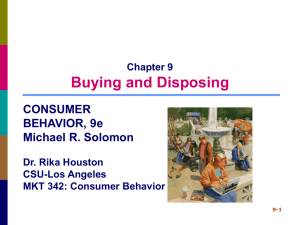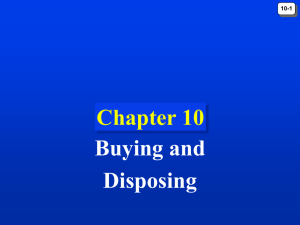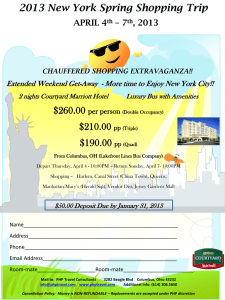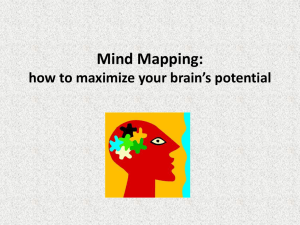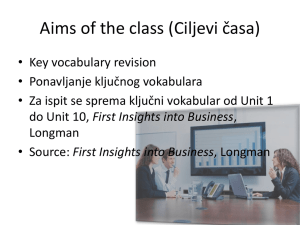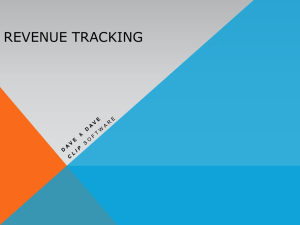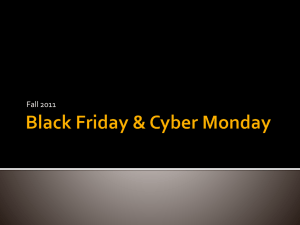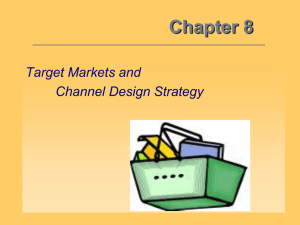CA2018 Buying and Disposing_upload
advertisement
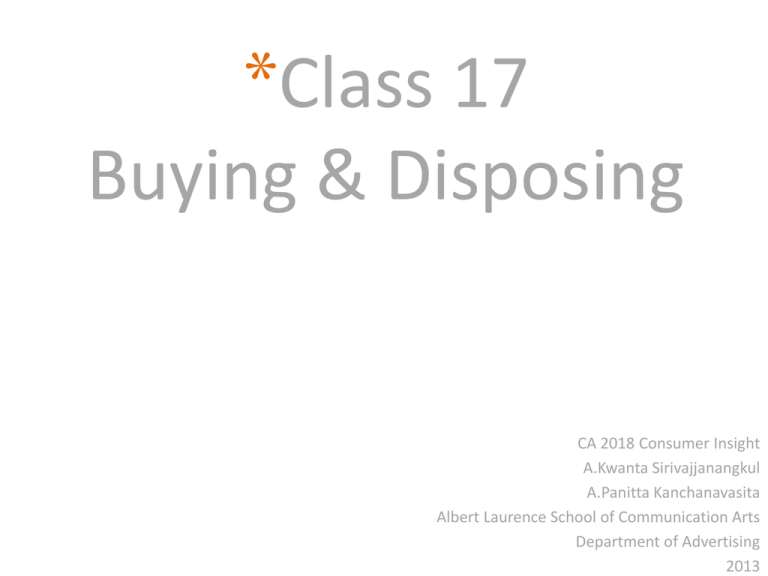
*Class 17 Buying & Disposing CA 2018 Consumer Insight A.Kwanta Sirivajjanangkul A.Panitta Kanchanavasita Albert Laurence School of Communication Arts Department of Advertising 2013 *Consumers as Decision Makers Decision Making • Basic sequence of steps we undergo when we make decisions Buying and Disposing • How the particular situation in which we find ourselves affects these decisions and how we go about evaluating the results of our choices Group Influence and Opinion Leadership • An overview of group processes and discusses the reasons we are motivated to conform to the expectations of others when we choose and display our phurchases Organizational and Household Decision Making • The purchase decisions in conjunction with others, especially coworkers or family members * Chapter outline 1. Situational Effects on Consumer Behavior 2. The Shopping Experience • • • • Dimension of Emotional States Shopping Orientation Retailing as Theatre In-Store Decision Making 3. Postpurchase Satisfaction 4. Product Disposal 1 *Situational Effects on Consumer Behavior 1 * Why do many factors over the qualities of the product or service influence the outcome of a transaction? Why do factors at the time of purchase dramatically influence the consumer decisionmaking process? * Issues Related to Purchase and Postpurchase Activities Antecedent States • • • • • Situational Factors Usage Contexts Time Pressure Mood Shopping Orientation Purchase Environment • The Shopping Experience • Point-of-purchase Stimuli • Sales Interactions Postpurchase Processes • Consumer Satisfaction • Product Disposal • Alternative Markets 2 2 * Dimensions of Emotional States Distressing (Worrying) Arousing Exciting Unpleasant Pleasant Gloomy (Depressed) Relaxing Sleepy 2 * Shopping Orientation * General attitudes about shopping * shopping is how we acquire needed for products and services but social motives for shopping are also important * Shopping is as activity that we can perform for either utilitarian (functional or tangible) or hedonic (pleasurable or intangible) reasons * High heel shoes VS running shoes * quick lunch at work VS dinner with lover * It could depends on product category and store types 2 * Shopping Orientation Hedonic Shopping Motive: 1. Social Experience * ex. New department store opening 2. Sharing of common interests * ex. Golf equipment store, INDY music store, Baby and Kid store 3. Interpersonal attraction * ex. hangout places 4. Instant status * ex. Dressed up for shopping, feeling good when people treat you as an important person 5. The thrill of the hunt * some people pride themselves on their knowledge of the marketplace * ex . I know that vintage market, let me lead you there 2 * Retailing as Theatre * Retail Theming: many stores seek to create imaginative environments that transport shoppers to fantasy worlds or provide other kinds of simulation. * 4 Basic of theming techniques: 1. Landscape themes * nature, Earth, animals, physical body 2. Marketscape themes * man-made places ex. Venetian Hotel in Las Vegas 3. Cyberspace themes * Image of information and communication technology ex. eBAY interface , I-studio of Apple, 4. Mindscape themes * Abstract ideas and concepts, introspection and fantasy, spiritual overtones ex. Spa, boutique hotels 2 * Retailing as Theatre * Being Space: convert a store into a being space * Ex. Starbuck Coffee provides various styles of living room *With the concept “the third place” *Relax, entertain, hang out, escape, work * Pop Up Store: one kind of being spaces, which is a temporary installations that do business only for a few days or weeks 2 * In-Store Decision Making * Spontaneous Shopping: when a shopper suddenly decides to buy something in the store, one of two different processes explains this: 1. Unplanned Buying * Mostly, unplanned buying occurs because a shopper recognizes a new need while they are in the store * Unfamiliar with a store’s layout, under some time pressure, * Seeing items on a store shelf and reminding to the needs 2. Impulse Buying * A sudden urge they simple can’t resist * Ex. Candy, gum * Point of Purchase Stimuli: A POP can elaborate product display or demonstration, a coupon machine, or an employee who gives out free samples of a new cookies * Product samples, package displays, place-based media, instore promotional material, shelf talkers 3 *Postpurchase Satisfaction 3 * Postpurchase Satisfaction *Consumer Satisfaction/Dissatisfaction *Our overall feelings about a product after we have bought it *It plays an important role in future behavior *We form beliefs about product performance based on prior experience with the product or communications about the product certain level of quality * What will we do when we are not satisfied? 3 * Postpurchase Satisfaction What will we do when we are not satisfied? * 3 possible courses of action 1. Voice Response * You can appeal directly to the retailer 2. Private Response * You can express your satisfaction to friends and boycott the product or the store where you bought it 3. Third-party Response * You can take legal action against merchant * Or write a letter to newspaper 3 *Product Disposal 3 * Product Disposal *How to get rid of products when consumers no longer need or want *Recycling is one option that will become more crucial as consumers’ environmental awareness grows *Lateral cycling occurs when we buy, sell, or barter secondhand objects Any Question?
